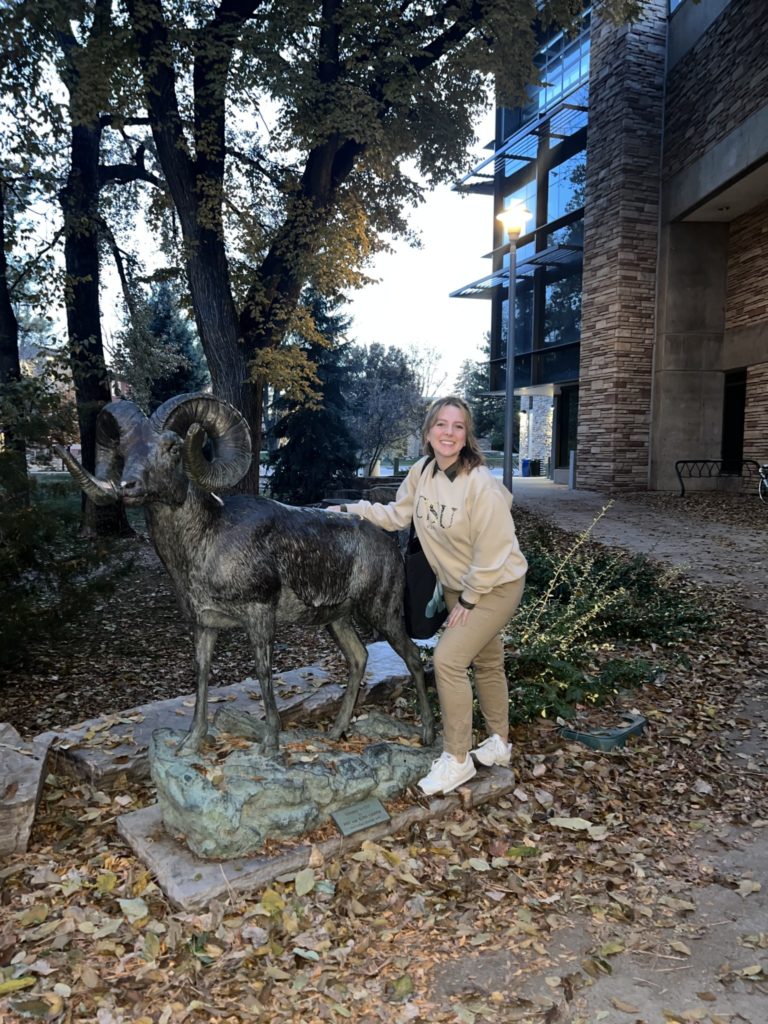Another semester is nearing its conclusion and with it comes a new batch of graduates beaming with excitement for their accomplishments and eagerness for life’s next steps. Across seven areas within Human Dimensions of Natural Resources, the department is set to celebrate 145 graduates on Friday, Dec. 15th. For the most up-to-date information on 2023 Commencement Celebrations, visit the University’s Commencement website.
In this series, we will feature one student from each of the seven areas of HDNR. First up is Kaitlyn Stabell from cohort 12 of the Master of Conservation Leadership program. Stabell, of La Center, Washington, completed the 18-month program with a capstone project titled, “Planning for a Potential Wolverine Reintroduction to Colorado”. Working alongside classmate Astghik Markosyan and partner organizations Rocky Mountain Wild and Denver Zoo, the project made major progress in building a diverse coalition to improve the future integrity of a possible reintroduction initiative.
Two steps ahead of the curve, Stabell not only has a full-time job lined up, but she’s already started it. In October, she began her position as a Community Outreach and Engagement Coordinator for the Douglas Land Conservancy. The Douglas Land Conservancy (DLC) is a nonprofit made up of citizens concerned about land conservation and smart growth in the Douglas County region of Colorado, which is the Colorado Springs area.
Q&A with Kaitlyn:
What was your favorite HDNR course and why?
“I loved all of them for different reasons, but I grew the most from the Multi-level Views of Conservation course with Jen Solomon. I was forced to confront hard truths about the past and present of conservation, much of which I had never been exposed to before. Among many other things, the class gave me a deeper appreciation of the absolute need for collaboration across fields, not just within, to create better outcomes for the earth and for the humans who depend on it.”
During school, did you gain experience with a related job?
“Yes! I worked as a student contractor with USGS at the
Fort Collins Science Center during the program. I was a part of the Wild Horse and Burro research lab, and helped USGS biologists and post-docs with their data. It was great for building database and data analysis skills, but what I enjoyed most was getting an inside look into trends in the data, long before they ever got published.”
What was the most enjoyable part of your HDNR journey?
“My cohort-mates! I would have been happy learning just from the professors and the field experiences, but a big emphasis of this program is about building relationships and sharing knowledge amongst each other. I gained so much perspective from their willingness to share their own lived experiences, conservation-related and not. My time in the program wouldn’t have been the same without them. Our frequent outings to New Belgium were a close second.”
“For years, I was on the M.S. Wildlife Biology track. My senior year of undergrad, I was researching and applying to labs when I had the epiphany that the problems I wanted to help solve weren’t with animals, they were with humans. Days later, the MCL program randomly popped up on my Instagram feed and after some research, I emailed the program coordinator asking if it was too late to apply for the upcoming fall cohort. I applied and was accepted! I couldn’t be happier with my choice to join HDNR. I feel like there’s so many possibilities open to me for my career as a conservationist because of this program, and I’m certainly a better leader and person because of it.”
What are you most excited about with your future career?
“I’m excited to work at different scales and in different sectors of the field. I’ve worked for federal and state governments as a wildlife tech and in education/interpretation, and now I’m with a nonprofit on a local scale. It’s heartening to see firsthand that positive change is happening on so many levels, in so many different ways, and I’m just looking forward to contributing to those efforts however I can.”
“That’s a tough question. I would love to be a wildlife veterinarian or a National Geographic photographer. More realistically, I’d like to be the Executive Director of a wildlife conservation nonprofit.”


